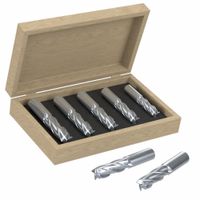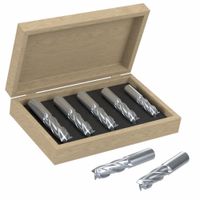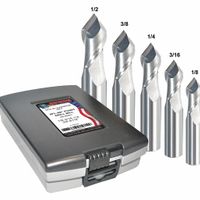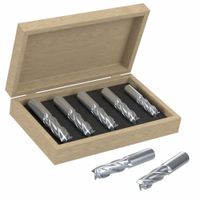Call +(254) 703 030 000 / 751 483 999 / 721 704 777
.....Read More
Frequently Asked Questions
What are the different types of end mills included in a set?
A set of end mills typically includes a variety of types, each designed for specific milling tasks. Here are the common types:
1. **Square End Mills**: These have a flat bottom and are used for general-purpose milling, including slotting, profiling, and plunge cutting.
2. **Ball Nose End Mills**: Featuring a rounded tip, these are ideal for 3D contouring and machining complex surfaces, as they provide a smooth finish.
3. **Corner Radius End Mills**: These have a rounded corner, which reduces chipping and extends tool life, making them suitable for milling rounded edges and corners.
4. **Roughing End Mills**: Also known as hog mills, these have serrated cutting edges to remove large amounts of material quickly, ideal for roughing operations.
5. **Finishing End Mills**: Designed for fine surface finishes, these have a smooth cutting edge and are used after roughing to achieve precise dimensions and surface quality.
6. **Tapered End Mills**: These have a conical shape and are used for machining angled surfaces, such as in mold making and die casting.
7. **Chamfer End Mills**: Used to create beveled edges or to remove burrs, these have an angled cutting edge.
8. **Double-End End Mills**: These have cutting edges on both ends, allowing for extended tool life and cost efficiency.
9. **Single Flute End Mills**: With one cutting edge, these are used for high-speed machining and are effective in soft materials like plastics and aluminum.
10. **Multi-Flute End Mills**: With more than two flutes, these provide a smoother finish and are used for finishing operations in harder materials.
11. **Variable Helix End Mills**: Designed to reduce vibrations and improve surface finish, these have flutes with varying helix angles.
Each type serves a specific purpose, allowing machinists to select the appropriate tool for their specific milling needs.
How do I choose the right end mill set for my needs?
1. **Material Compatibility**: Choose end mills made from materials suitable for the workpiece material. High-speed steel (HSS) is versatile, while carbide is ideal for harder materials.
2. **Coating**: Select coatings like TiN, TiCN, or TiAlN to enhance tool life and performance, especially for high-speed applications or abrasive materials.
3. **Flute Count**: More flutes provide a smoother finish and are suitable for harder materials, while fewer flutes offer better chip clearance for softer materials.
4. **End Mill Type**:
- **Square End**: For general-purpose milling.
- **Ball Nose**: For 3D contouring and smooth finishes.
- **Corner Radius**: For added strength and reduced chipping.
5. **Size and Length**: Match the end mill size to the feature size and depth of cut. Longer end mills offer deeper cuts but may deflect more.
6. **Helix Angle**: A higher helix angle provides a smoother finish and is better for softer materials, while a lower angle is suitable for harder materials.
7. **Shank Type**: Ensure compatibility with your machine’s collet or holder. Weldon shanks provide better grip, while straight shanks are more common.
8. **Application**: Consider the specific operations (e.g., roughing, finishing) and choose end mills designed for those tasks.
9. **Budget**: Balance cost with quality. Investing in higher-quality end mills can reduce tool replacement frequency and improve results.
10. **Brand and Supplier**: Choose reputable brands and suppliers for reliable quality and support.
11. **Trial and Feedback**: Test different end mills and gather feedback on performance to refine your selection process.
What materials can be machined with end mills?
End mills are versatile cutting tools used in milling applications to remove material from a workpiece. They can machine a wide range of materials, including:
1. **Metals:**
- **Steel:** Both carbon and alloy steels, including stainless steel, can be machined with end mills. High-speed steel (HSS) and carbide end mills are commonly used.
- **Aluminum:** Due to its softness and malleability, aluminum is easily machined with end mills, often using carbide tools for better performance.
- **Brass and Copper:** These softer metals are machined with end mills, typically using HSS or carbide tools.
- **Titanium:** Requires specialized end mills, often with coatings like TiAlN, due to its strength and heat resistance.
- **Cast Iron:** Machined with carbide end mills, as it is abrasive and requires durable tools.
2. **Plastics:**
- **Acrylic, Polycarbonate, and PVC:** These materials are machined with end mills designed for plastics, often with a high helix angle to ensure smooth cutting.
- **Nylon and Delrin:** Require sharp end mills to prevent melting and ensure clean cuts.
3. **Composites:**
- **Fiberglass and Carbon Fiber:** Machined with diamond-coated or carbide end mills to handle the abrasive nature of these materials.
- **G10 and FR4:** Require specialized end mills to manage the layered structure and prevent delamination.
4. **Wood:**
- **Hardwoods and Softwoods:** Machined with end mills designed for woodworking, often with a high helix angle for efficient chip removal.
5. **Ceramics and Glass:**
- Machined with diamond-coated end mills due to their hardness and brittleness.
End mills are selected based on the material's properties, such as hardness, toughness, and abrasiveness, to ensure efficient machining and tool longevity.
How do I maintain and care for my end mill set?
1. **Cleaning**: After each use, clean the end mills with a brush to remove chips and debris. Use compressed air to blow out any remaining particles.
2. **Inspection**: Regularly inspect the end mills for wear, chipping, or damage. Check the cutting edges and shank for any signs of wear or damage.
3. **Sharpening**: Sharpen the end mills when they become dull. Use a tool grinder or send them to a professional sharpening service to maintain the cutting efficiency.
4. **Lubrication**: Apply a light coat of oil to the end mills after cleaning to prevent rust and corrosion. Use a rust-preventive oil for storage.
5. **Storage**: Store end mills in a dry, organized manner. Use a dedicated tool holder or rack to prevent them from knocking against each other, which can cause damage.
6. **Proper Use**: Use the correct end mill for the material and application. Avoid excessive speeds and feeds that can cause overheating and wear.
7. **Coolant**: Use appropriate coolant or cutting fluid during operation to reduce heat and friction, extending the life of the end mills.
8. **Handling**: Handle end mills carefully to avoid dropping or banging them, which can cause chipping or misalignment.
9. **Inventory Management**: Keep track of the usage and condition of each end mill. Rotate them to ensure even wear and replace them when necessary.
10. **Environment**: Store and use end mills in a stable environment, avoiding extreme temperatures and humidity that can affect their integrity.
By following these steps, you can extend the life of your end mill set and maintain their performance.
What is the difference between 2-flute and 4-flute end mills?
2-flute end mills have two cutting edges and are typically used for cutting softer materials like aluminum. They provide larger chip clearance, which helps prevent clogging and allows for faster material removal. This makes them ideal for slotting operations and when working with non-ferrous metals. The larger space between the flutes also allows for better chip evacuation, reducing heat buildup and tool wear.
4-flute end mills, on the other hand, have four cutting edges and are generally used for harder materials like steel. They offer a smoother finish due to the increased number of cutting edges, which distribute the cutting load more evenly. This results in less vibration and a finer surface finish. However, the smaller flute space can lead to chip congestion, making them less suitable for deep slotting in softer materials. They are better suited for side milling and finishing operations where a high-quality surface finish is required.
In summary, the choice between 2-flute and 4-flute end mills depends on the material being machined and the desired finish. 2-flute end mills are preferred for softer materials and roughing operations, while 4-flute end mills are better for harder materials and finishing tasks.
How do I determine the correct speed and feed rate for end mills?
To determine the correct speed and feed rate for end mills, consider the following factors:
1. **Material**: Identify the material of the workpiece (e.g., aluminum, steel, plastic) as different materials require different speeds and feeds.
2. **Tool Material**: Consider the material of the end mill (e.g., high-speed steel, carbide) since it affects the cutting speed and feed rate.
3. **Tool Diameter**: Larger diameter tools can handle higher speeds and feeds compared to smaller ones.
4. **Number of Flutes**: More flutes allow for higher feed rates but may require slower speeds to avoid excessive heat.
5. **Cutting Speed (SFM)**: Use the formula: SFM = (π × Diameter × RPM) / 12. Reference material-specific SFM charts to find the recommended cutting speed.
6. **Spindle Speed (RPM)**: Calculate using: RPM = (SFM × 12) / (π × Diameter). Adjust based on machine capabilities and tool specifications.
7. **Feed Rate (IPM)**: Calculate using: IPM = RPM × Number of Flutes × Chip Load. Chip load is the thickness of the material removed by each cutting edge per revolution, found in manufacturer charts.
8. **Depth of Cut**: Shallower cuts can allow for higher speeds and feeds, while deeper cuts require more conservative settings.
9. **Machine Power and Rigidity**: Ensure the machine can handle the calculated speeds and feeds without excessive vibration or power overload.
10. **Coolant Use**: Proper coolant can allow for higher speeds and feeds by reducing heat and friction.
11. **Trial and Error**: Start with conservative settings and gradually increase to optimize performance while monitoring tool wear and surface finish.
12. **Software and Calculators**: Utilize CNC software or online calculators for precise calculations based on the above factors.
Adjust these parameters based on real-time observations and specific machining conditions to achieve optimal performance.
Can end mills be used for drilling?
Yes, end mills can be used for drilling, but with certain limitations and considerations. End mills are primarily designed for side milling, contouring, and profiling, but they can perform drilling tasks under specific conditions.
When using an end mill for drilling, it's important to use a center-cutting end mill, which has cutting edges at the tip that allow it to plunge into the material. Non-center-cutting end mills lack this feature and cannot be used for drilling.
End mills are typically used for shallow drilling operations due to their design. They are not as efficient as dedicated drill bits for deep holes because they lack the fluting and geometry optimized for chip evacuation in deep drilling. For deeper holes, peck drilling or using a drill bit is recommended to prevent tool breakage and ensure proper chip removal.
The material being drilled also affects the feasibility of using an end mill. Softer materials like aluminum or plastic are more suitable for end mill drilling, while harder materials may require specialized tools or techniques.
Additionally, the machine's capabilities, such as spindle speed, feed rate, and rigidity, play a crucial role in successful end mill drilling. Proper setup and parameters are essential to avoid tool damage and achieve the desired results.
In summary, while end mills can be used for drilling, they are best suited for shallow holes and specific applications. For optimal performance and efficiency, dedicated drill bits are recommended for traditional drilling tasks.



